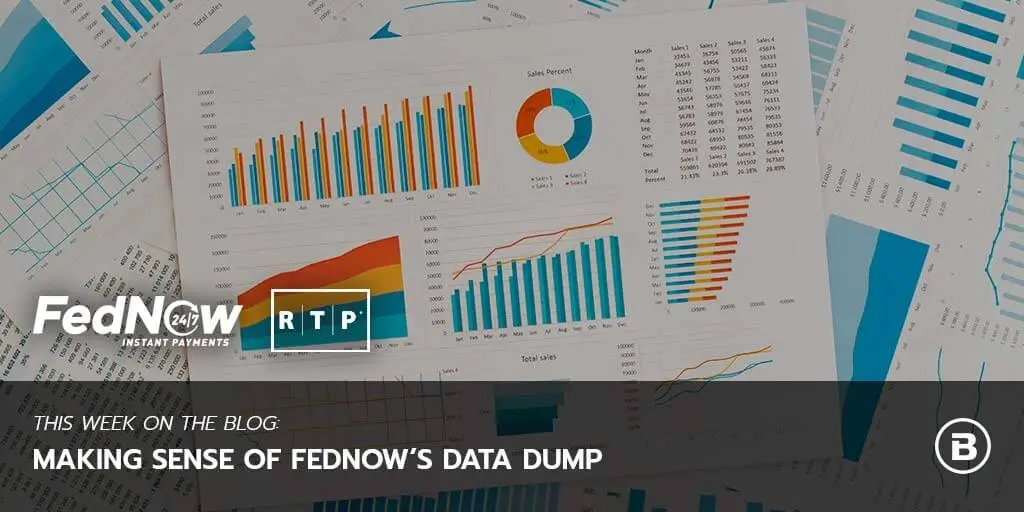Keep pace with the rapidly evolving fintech industry by subscribing to the BIGcast Network. Get weekly insights from industry leaders John Best and Glen Sarvady, delivered straight to your preferred podcast platform. Join our community and stay informed about the latest trends shaping the credit union industry. Subscribe today and ensure you’re always ahead of the curve.

Making Sense of FedNow’s Data Dump
Almost precisely sixteen months after launching its long anticipated network of instant payment rails, in late November the Federal Reserve finally shared volume metrics for its FedNow service. While a welcome addition to our understanding of the landscape, the data is of the “glass half full/half empty” variety, and so far raises as many questions as it answers.
First the good news: As previously reported, the Fed has surpassed 1,000 financial institutions live on the FedNow service, already exceeding the 750 on The Clearing House’s competing RTP network, which recently celebrated the seventh anniversary of its launch. FedNow is showing solid momentum in other areas as well, its transaction volume more than doubling quarter-over-quarter in two of the past three cycles.
The bad news is that volume remains quite low- an average of 3,657 payments settled per day, to be specific. Contrast this to The Clearing House’s November announcement that its RTP network is now averaging 1 million payments per day. Although RTP has the benefit of a significant head start, the difference is nonetheless striking.
One of FedNow’s major challenges is that its FI roster is comprised primarily of small banks and credit unions compared to RTP’s larger players- including most of its 23 owner banks. An even greater (and hopefully temporary) volume barrier is that most of FedNow’s participants remain in “receive-only” mode (neither service discloses the number of FIs actively initiating transactions).
Then there’s the weird news. Despite a more than 300x advantage in transactions processed, RTP is carrying less than 3 times as much in dollar flow. Said another way, the average RTP payment is $800. For FedNow, the average is nearly $52,000. Clearly the two services are being used in very different ways. Business-to-Business and Account-to-Account use cases, both of which usually involve higher ticket sizes, were the first to find traction on instant payment rails. RTP has added P2P activity from the likes of Venmo and PayPal (and to a lesser extent its sister service Zelle) to its mix, driving down its average transaction size.
On the other hand FedNow’s $58,000 average is surprising on two fronts. First, it runs counter to the service’s lower transaction limit ($500K as compared to RTP’s $1 million- to be raised to $10 million in February). Second, the FedNow average spiked over the past three months; Until April it was below RTP’s. This may be the “Law of Small Numbers” at work. It may also be an early sign of activity from US Treasury Services, which has long been considered a FedNow ace in the hole. This trend bears watching.
In a separate disclosure via the Federal Register, the Fed revealed estimated FedNow system costs of $245 million for 2024, with a similar expense figure projected for 2025. Major system launches like these deserve time to scale but nonetheless, FedNow’s implied cost per transaction is… troubling. With a strong fourth quarter FedNow could eclipse 1.2 million transactions processed for 2024. Even this optimistic projection equates to a whopping cost per transaction of $200.
Assuming FedNow can hold operating expenses steady over time- an aggressive but plausible assumption, given technology cost curves- it will need to process volume equivalent to one-fifth of today’s ACH throughput in order to break even on an annual basis. Given the natural upward macro trends, the likely creation of new instant payment use cases and perhaps some cannibalization of existing ACH volumes, this may indeed be achievable in 6-8 years. New Federal Reserve products are normally expected to recapture startup costs within ten years, however. Several more deficit years appear inevitable before FedNow reaches break even.
To end on a positive note, the Fed has presumably established a reporting precedent that will allow us to track its progress going forward. And it’s definitely worth tracking, both on its own and in the context of other payment alternatives.
(Check out our interview with Payfinia and early adopter Star One Credit Union for a front line perspective on instant payments: https://www.big-fintech.com/Media?p=can-instant-payments-accelerate)
